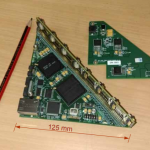
ICAL is Iron-Calorimeter to be set up by the Indiabased Neutrino Observatory (INO) collaboration, inside an underground cavern, to study neutrinos. The ICAL will study atmospheric neutrinos to determine their mass hierarchy among other things.
The ICAL will use magnetized iron as its target mass and glass Resistive Plate Chambers as the active detector element.

While using Wiznet in TCP mode Data Transmission is reliable as every byte sent is received correctly at the destination.
Majority of time is spent in “writing to FIFO”. Aim should be to reduce this time to increase the data rate.
We are able to achieve 18 Mbps data rate (for single socket) by increasing the NIOS2 clock frequency up to 100MHz. If we can reduce the FIFO write time up to 50ns/byte (minimum time as per datasheet of W5300) then the throughput rate estimation is coming near to 50 Mbps.
Also we observed that the optimal packet size for data transfer is 1280 bytes.
For more detail, go to http://ibss2015.ieeebombay.org/wp-content/uploads/2015/10/d2s1t4.pdf


COMMENTS